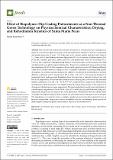Please use this identifier to cite or link to this item:
http://hdl.handle.net/11547/11143| Title: | Effect of Biopolymer Dip-Coating Pretreatments as a Non-Thermal Green Technology on Physicochemical Characteristics, Drying, and Rehydration Kinetics of Santa Maria Pears |
| Authors: | Nasim, Kian-Pour, |
| Keywords: | PHYSICAL-PROPERTIES PHENOLIC-COMPOUNDS |
| Issue Date: | 2023 |
| Series/Report no.: | 2304-8158; |
| Abstract: | This research was conducted to determine the influences of biopolymer dip-coating pretreatments as a non-thermal green technology on the drying behavior, retention of bioactive compounds, and quality properties of pears. The fresh pears were washed, peeled, and diced into cubes of 5 x 5 mm with a 2 mm thickness and were dipped into 0.3% (w/v) solutions of sodium alginate (SA), pectin (PC), xanthan gum (XG), Arabic gum (AG), and gelatin (GE) before hot air drying (70 & DEG;C, 2.0 m/s). The weight loss of samples during drying was recorded online, and the moisture ratio (MR) and drying rate were plotted against drying time. Biopolymers significantly decreased the drying time (maximum 33.33% by SA) compared with uncoated samples except for XG. Moisture diffusion coefficients were determined according to Fick's second law of diffusion by plotting LnMR against drying time, and a linear regression analysis was applied to the data for the determination of moisture diffusion coefficients which ranged from 2.332 to 3.256 x 10(-9) m(2)/s. The molecular transport of momentum, heat, and mass were determined from Newton's law of viscosity, Fourier's law, and Fick's law, respectively. The results indicated that the friction drag force, convective heat, and mass transfer coefficients were 6.104 x 10(-6) N, 76.55 W/m(2)& BULL;K, and 0.0636 m/s, respectively. Mathematical modeling showed the suitability of the Midilli and Kucuk and the Peleg models for the prediction of drying and rehydration processes, respectively. Thermal conductivity, specific heat, and density of coated samples ranged from 0.559-0.579 (W/m & BULL;K), 3735-3859 (J/kg & BULL;K), and 850.90-883.26 (Kg/m(3)), respectively. The porosity was reduced due to the penetration of biopolymers into the cellular matrix of samples. The highest total polyphenol content and antioxidant activity belonged to the AG samples. The biopolymers covering the surface of samples produced a protection layer against the loss of bioactive compounds. Biopolymers can be successfully used as a non-thermal green process for improving the drying and quality characteristics of pears at the industrial level. |
| URI: | http://hdl.handle.net/11547/11143 |
| Appears in Collections: | Web Of Science |
Files in This Item:
| File | Description | Size | Format | |
|---|---|---|---|---|
| foods-12-02466-v2.pdf | 2.65 MB | Adobe PDF |  View/Open |
Items in DSpace are protected by copyright, with all rights reserved, unless otherwise indicated.
